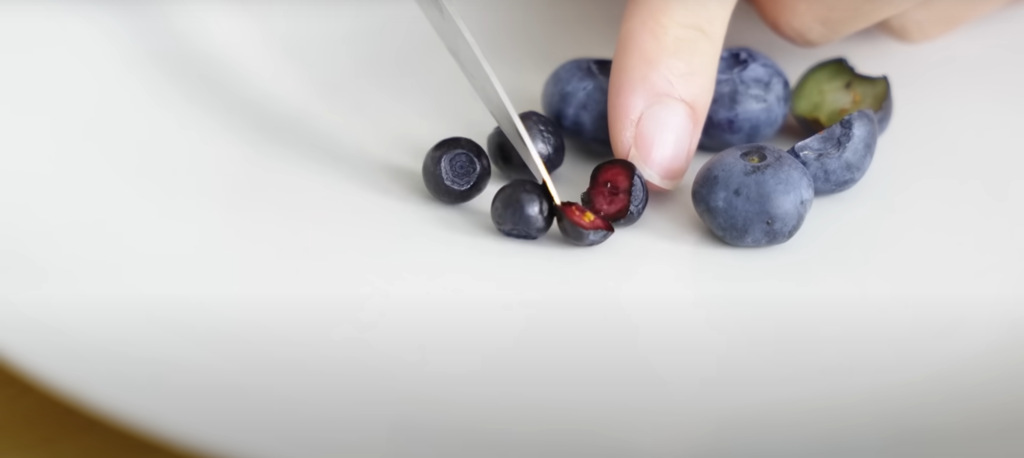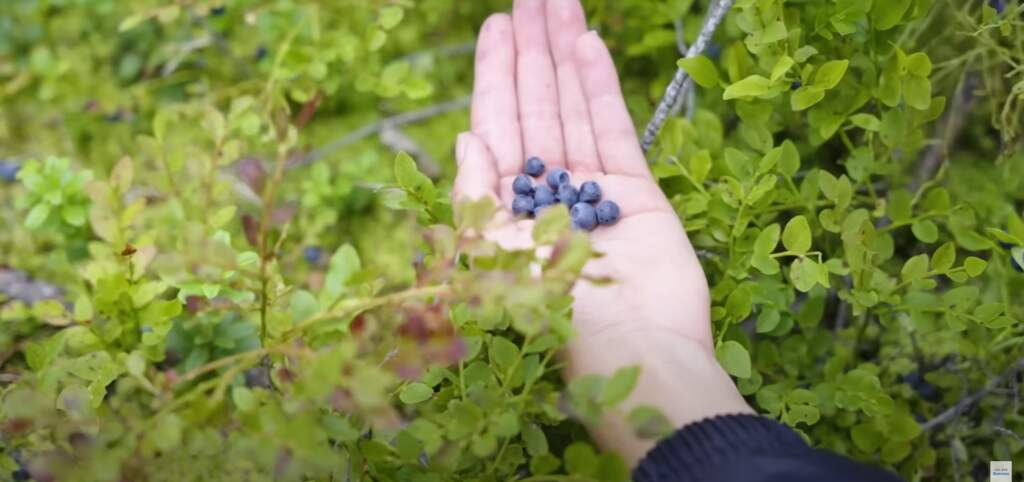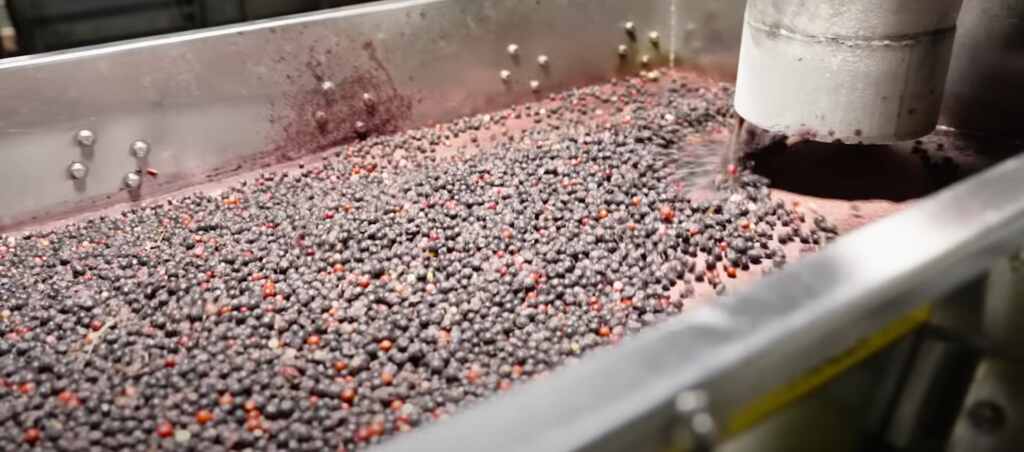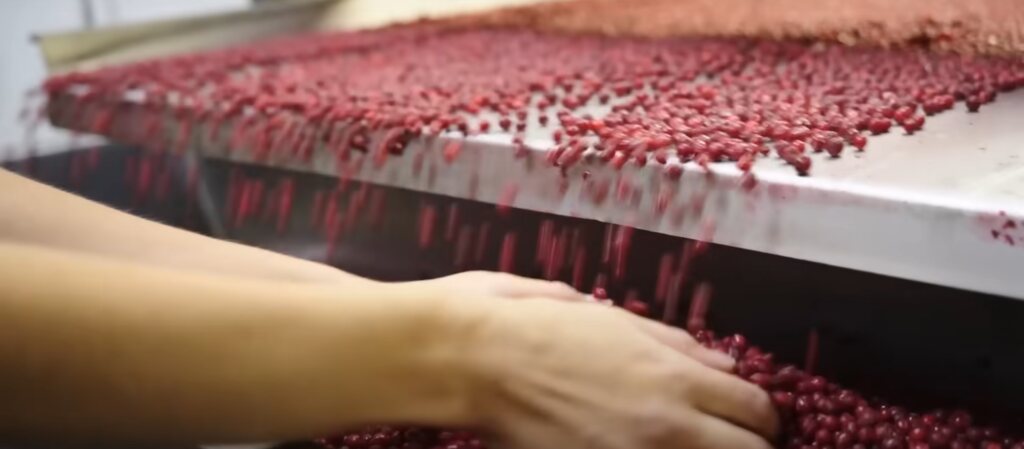Short answer: The flesh of a blueberry can be white, green or yellow. It depends on many things, let’s find it out!
🔑 Keypoints: 🔑
While most blueberries have a deep blue color inside, it’s not uncommon to come across green inside blueberries.
This variation in color is completely natural and does not affect the taste or nutritional value of the fruit.
You can still enjoy green inside blueberries without any worries.
Blueberries are delicious little fruits that are loved by many. But have you ever wondered what’s really inside of a blueberry? In this article, we will dive deep into the inner world of blueberries and uncover some surprising truths about their composition.
Understanding what’s inside a blueberry is not only fascinating but also important for appreciating the nutritional value they provide.
Blueberries are known for their vibrant blue color, but did you know that the color of a blueberry can vary? It turns out that not all blueberries are blue on the inside!
We’ll explore this intriguing aspect further and reveal why some blueberries are green inside. Get ready to be amazed by the secrets hidden within these tiny fruits!
So, get ready to embark on a journey of discovery as we peel back the layers of a blueberry and unravel its mysteries. Let’s explore the surprising truth about what’s really inside a blueberry!

Inside of a Blueberry
Biting into a blueberry reveals a burst of sweet juice, but what lies beneath its vibrant skin? Let’s explore the hidden treasures inside.
- The inside of a blueberry is not just a hollow shell, but rather a world of flavor and nutrition waiting to be discovered. The flesh of a blueberry is soft and succulent, providing a delightful texture that adds to the overall eating experience.
- One of the most intriguing aspects of the inside of a blueberry is its tiny seeds. Unlike some fruits where the seeds are discarded, blueberry seeds are not only edible but also packed with nutrients. These seeds contain fiber, healthy fats, and antioxidants, making them a valuable addition to your diet.
- Blueberries have a unique texture on the inside, with their flesh being delicate and tender. When you bite into a ripe blueberry, it practically melts in your mouth, releasing its sweet and tangy flavors in every bite.
Blueberry flesh can vary in color from pale green to dark blue. Factors contributing to this variation include:
- Genetics: Different blueberry varieties have distinct genetic traits that influence the color of their flesh. Some varieties tend to have more intense shades of blue, while others may lean towards green hues.
- Growing Conditions: Environmental factors such as soil composition, sunlight exposure, and temperature can impact the color intensity of blueberries. For example, blueberries grown in acidic soils tend to develop deeper shades of blue.
- Maturity and Ripeness: As blueberries ripen, their inner color undergoes changes. Immature berries may have greenish flesh, which gradually transforms into a vibrant blue as they mature. It’s important to note that green inside blueberries are safe to eat and can still provide a delicious taste.
Blueberries are blue inside because of anthocyanins, natural compounds that give them their rich blue color. Anthocyanins provide health benefits like antioxidants and anti-inflammatory properties.
While most blueberries have a deep blue color inside, it’s not uncommon to come across green inside blueberries. This variation in color is completely natural and does not affect the taste or nutritional value of the fruit. You can still enjoy green inside blueberries without any worries.
In conclusion, the inside of a blueberry holds more than just sweetness and juiciness. It contains tiny seeds that are packed with nutrients and contributes to the overall health benefits of this superfood. The color variation in blueberry flesh adds an element of intrigue and diversity, making each bite a delightful surprise. So go ahead and savor the wonders that lie within every blueberry you enjoy!

Color and Antioxidants
Blueberries are not only known for their delicious taste, but also for their vibrant color. The color of blueberries is actually a reflection of the antioxidants they contain.
In this section, we will explore the fascinating relationship between color and antioxidant content in blueberries, as well as the health benefits associated with these compounds.
Relationship between Color and Antioxidant Content
The deep blue hue of blueberries is primarily due to a group of pigments called anthocyanins. Anthocyanins are powerful antioxidants that protect the berries from oxidative damage caused by free radicals. These compounds play a crucial role in the plant’s defense system and help attract pollinators.
Interestingly, the intensity of color in blueberries can vary depending on various factors such as ripeness, variety, and growing conditions. Generally, darker blueberries tend to have higher levels of anthocyanins and antioxidants compared to lighter ones. This means that the more intense the color, the more potent the antioxidant content.
Blueberry Seeds
Blueberry seeds may seem small and inconspicuous, but they play a vital role in the growth and propagation of blueberries. Let’s explore the characteristics, importance, and differences between cultivated and wild blueberry seeds.
Characteristics and Importance of Blueberry Seeds
- Blueberry seeds are tiny, oval-shaped structures found inside the fruit. They are usually dark brown or black in color.
- Despite their small size, blueberry seeds contain essential nutrients and compounds that contribute to the overall health benefits of blueberries.
- These seeds are rich in antioxidants, healthy fats, fiber, and vitamins. They also contain trace minerals like manganese, which is crucial for bone health and metabolism.
- Blueberry seeds are an excellent source of dietary fiber, aiding digestion and promoting a healthy gut.
- The presence of omega-3 fatty acids in blueberry seeds contributes to their anti-inflammatory properties, benefiting cardiovascular health.
Also read: https://howisdom.com/pedialyte/
Comparison between Cultivated and Wild Blueberry Seeds
Cultivated blueberries are typically larger and have fewer seeds compared to their wild counterparts. This difference is due to selective breeding practices aimed at enhancing desirable traits such as size and sweetness.
On the other hand, wild blueberries have smaller fruits with more abundant seeds. These seeds can vary in color from light yellow to reddish-brown. Wild blueberries are known for their intense flavor and higher antioxidant content.

Role of Seeds in Propagation and Growth of Blueberries
Blueberry seeds are essential for the reproduction and growth of blueberry plants. When a seed is planted in suitable conditions, it germinates and develops into a young plant.
During germination, the seed absorbs water and nutrients from the soil. It then sprouts a root system that anchors it into the ground while absorbing additional nutrients for growth.
In summary, blueberry seeds are not just an afterthought when enjoying this delicious fruit. They contain valuable nutrients and compounds that contribute to the overall health benefits of blueberries. Whether cultivated or wild, these tiny seeds play a crucial role in the propagation and growth of blueberry plants.
So, next time you enjoy a handful of blueberries, remember to appreciate the hidden power within their seeds.
As the plant matures, it forms new shoots that eventually develop into branches bearing flowers. These flowers undergo pollination by insects or wind, resulting in the formation of new blueberries.
Explanation of Anthocyanins and Their Health Benefits
Anthocyanins are not only responsible for the vibrant color of blueberries but also offer numerous health benefits when consumed. These antioxidants have been linked to various positive effects on human health, including:
- Reduced Risk of Chronic Diseases: Anthocyanins have been shown to have anti-inflammatory and antioxidant properties, which can help protect against chronic diseases such as heart disease, diabetes, and certain types of cancer.
- Improved Brain Function: Research suggests that anthocyanins may improve memory and cognitive function by reducing oxidative stress and inflammation in the brain.
- Enhanced Eye Health: The antioxidants found in blueberries, including anthocyanins, may help protect against age-related macular degeneration (AMD) and cataracts.
- Anti-Aging Properties: Blueberries’ high antioxidant content can help combat oxidative stress, which is a major contributor to aging and age-related diseases.

Discussion on How Color Contributes to Nutritional Value
The color of blueberries goes beyond visual appeal; it also indicates their nutritional value. The deep blue color signifies the presence of anthocyanins, which are key contributors to the overall antioxidant capacity of blueberries. This means that darker blueberries generally offer more health benefits due to their higher antioxidant content.
Moreover, the rich color of blueberries can also be an indicator of other beneficial compounds such as flavonoids, vitamins, and minerals. These nutrients work synergistically with the antioxidants to support overall health and well-being.
It’s important to note that while fresh blueberries are a great source of antioxidants, freezing or drying them does not significantly reduce their health benefits. This makes blueberries a convenient and versatile option to enjoy year-round.
In the next section, we will dive into the fascinating world of Nordic blueberries and explore their unique characteristics as well as the impact of summer conditions in the Arctic Circle on blueberry growth. Stay tuned for more intriguing insights into these delicious berries!
Nordic Blueberries and Arctic Flavors
Nordic blueberries are known for their unique characteristics and delicious taste. These small berries, also called bilberries, grow abundantly in the northern regions of Europe, particularly in the Arctic Circle. The summer conditions in this area play a significant role in the growth and development of these blueberries, making them distinct from other cultivated varieties.
In the Arctic Circle, the summer season is characterized by long days with extended sunlight. This phenomenon, known as the midnight sun, provides ample opportunity for blueberry plants to thrive and produce an abundance of flavorful fruits.
The continuous sunlight allows the plants to photosynthesize for longer periods, leading to increased sugar content and intense flavors in the berries.
Arctic Flavors is a term often associated with Nordic blueberries due to their exceptional taste and nutritional value. The cool climate and pristine environment contribute to their unique flavor profile, which is often described as sweeter and more intense than that of cultivated blueberries.
Where to Find Arctic Blueberries
If you’re eager to experience the delightful flavors of Arctic blueberries, there are several locations where you can find them:
- Scandinavian Countries: Norway, Sweden, Finland, and Denmark are among the primary regions where Nordic blueberries grow abundantly. These countries offer vast forests and open landscapes where wild blueberries can be found.
- Northern Russia: The northern parts of Russia, including Siberia, are also known for their wild blueberry populations. The remote wilderness of these areas provides an ideal habitat for these delicious berries.
- Alaska: In North America, Alaska is a prime location for finding wild blueberries reminiscent of their Nordic counterparts. The state’s cooler climate and pristine wilderness make it a perfect destination for blueberry enthusiasts.

Tips for Foraging Wild Nordic Blueberries
Foraging wild Nordic blueberries can be a rewarding experience. Here are some tips to help you make the most of your blueberry-picking adventure:
- Timing: Blueberries are typically ready for harvest in late summer, usually from July to September. Plan your trip accordingly to ensure you find ripe and flavorful berries.
- Location: Look for areas with a mix of open spaces and forests. Blueberries tend to thrive in sunny spots with well-drained soil.
- Identification: Familiarize yourself with the characteristics of Nordic blueberry plants to easily identify them in the wild. Pay attention to the shape and color of the leaves, as well as the appearance of the berries.
- Gathering Technique: Gently pluck the ripe blueberries from the plant, being careful not to damage the surrounding foliage. Use a container or basket to collect your harvest.
Cultivation Options for Those Outside the Arctic Region
If you don’t have access to wild Nordic blueberries, don’t worry! Cultivated blueberries are widely available and can be grown in various regions. Here are some cultivation options for those outside the Arctic:
- Container Gardening: Blueberry plants can be grown in containers, making them suitable for small spaces like balconies or patios. Choose a variety that is well-suited for your climate and provide the necessary care, including regular watering and proper soil acidity.
- Backyard Gardens: If you have a larger outdoor space, consider planting blueberry bushes directly in your garden. Ensure that the soil is acidic enough for optimal growth and provide adequate sunlight and water.
- Community Gardens: Joining a community garden can be a great way to grow blueberries if you lack space at home. Work collectively with other gardeners to create a thriving blueberry patch.
In conclusion, Nordic blueberries offer a unique flavor experience due to their association with Arctic Flavors and the summer conditions of the Arctic Circle. Whether you have access to wild blueberries or choose to cultivate your own, these berries are a delicious and nutritious addition to your diet. So, go ahead and explore the surprising world of blueberries, both inside and out!
Video guide
Conclusion
Now that we’ve explored the surprising truth about what’s really inside a blueberry, let’s recap what we’ve learned and reflect on the importance of blueberries and their various components.
Recap of the Surprising Truth:
- The inside of a blueberry is not only juicy and sweet, but it also contains tiny seeds that are not only edible but also rich in nutrients.
- Blueberries can be both blue and green inside, and both variations are safe to eat.
- The color of blueberries comes from a group of pigments called anthocyanins, which are not only responsible for the vibrant hues but are also packed with health benefits.
Importance of Blueberries:
- Blueberries are a delicious and nutritious fruit that can be enjoyed in various ways, such as snacking, baking, or adding to smoothies.
- Blueberries are rich in antioxidants, especially anthocyanins, which have been linked to numerous health benefits, including reduced inflammation and improved brain function.
- The seeds inside blueberries play a vital role in the propagation and growth of blueberry plants.
In conclusion, understanding what’s inside a blueberry allows us to appreciate this small fruit even more.
🔑 Key Takeaways: 🔑
✔️ Blueberries are not only tasty but also packed with nutrients and antioxidants that contribute to our overall well-being.
✔️ Whether you enjoy them fresh or incorporate them into your favorite recipes, blueberries offer a burst of flavor and a wealth of health benefits.
✔️ So next time you indulge in these little berries, remember their surprising truth and savor every bite.
✔️ Stay tuned for more fascinating insights into the world of blueberries!
Sources:
- https://www.ncbi.nlm.nih.gov/pmc/articles/PMC8389628/
- https://www.ncbi.nlm.nih.gov/pmc/articles/PMC9306956/
- Photos was taken by “Insider Business” Youtube channel.


